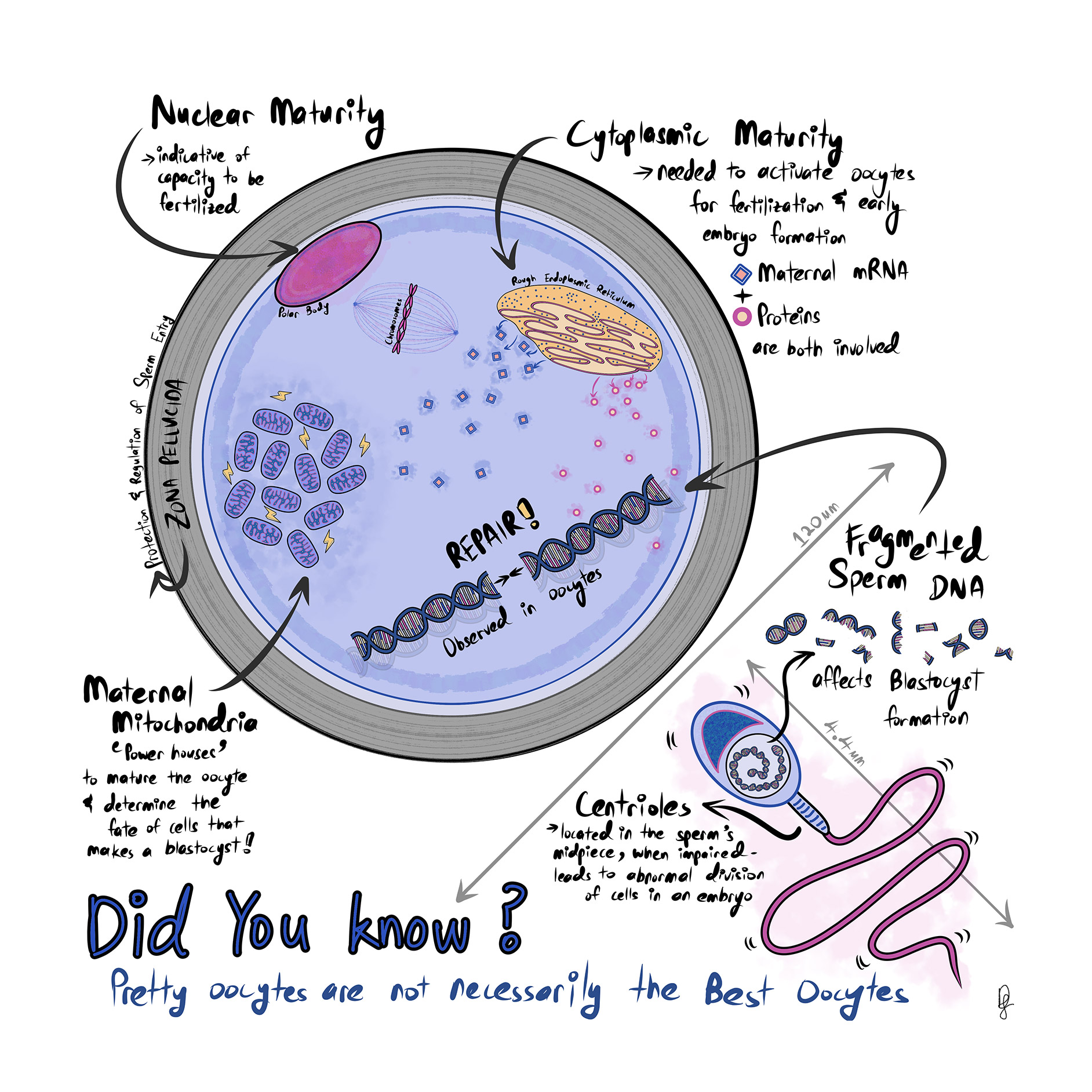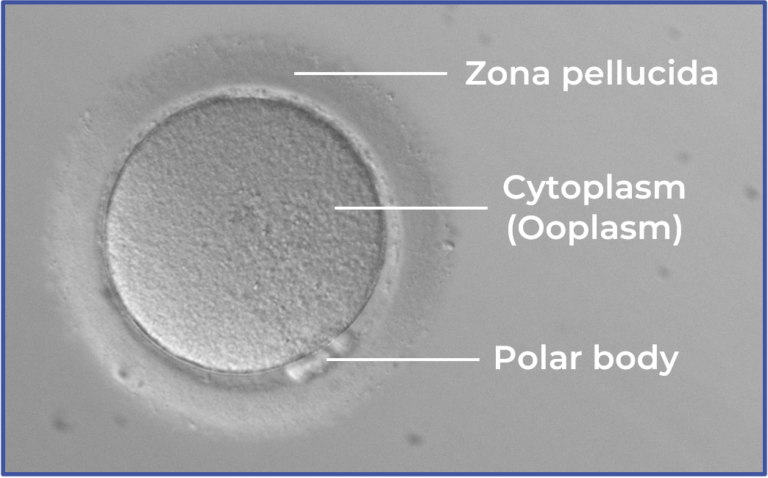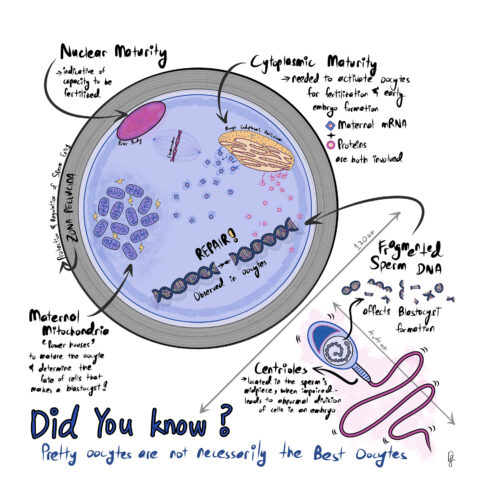In basic biology we learn that male & female gametes are each required to create an embryo, and that this embryo is comprised of equal parts male and female DNA. It’s reasonable to assume then that both are equally important to the process, however in reality, eggs contribute significantly more to successful embryo growth. Unlike the sperm, which is mainly a package to deliver the male DNA, the egg contributes DNA as well as numerous other important components of the cell that ultimately will form the embryo.
We were excited to work with Diana Tain, a senior embryologist and illustrator, to help visualize the key aspects of the egg that support healthy embryo development. Throughout her career, Diana has developed a passion for educating patients about the science behind their fertility journeys. During the pandemic, Diana took on a new hobby to visualize the learnings from reproductive research into fun illustrations – a project that has built a following on Instagram from other fertility professionals and patients alike.
We hope you’ll gain an appreciation for the big role that your eggs play on the path to successful pregnancy. Having personalized insights about your egg quality as you go through egg freezing or IVF can help to better understand your likelihood of success and assist your doctor in making better decisions about your treatment.

WHY ARE EACH OF THESE COMPONENTS IMPORTANT IN EMBRYO DEVELOPMENT?
Nuclear Maturity:
To understand nuclear maturity, it is important to understand the nucleus. The nucleus is the area of the egg cell (oocyte) where most of the genetic material (DNA) is stored. Early in the oocyte’s development, the nucleus is surrounded by a nuclear envelope, which separates the DNA inside the nucleus from the rest of the cell’s interior – the cytoplasm (or the “ooplasm” as it’s specifically called in an egg cell). The cytoplasm is made up of organelles (other structures with their own specialized functions) suspended in a fluid-like substance that fills the inside of the cell.
Nuclear maturity primarily refers to a couple of key developmental steps within the nucleus that must be true for fertilization to occur:
- The nuclear envelope breaks down, allowing the female DNA to be exposed in the cytoplasm so that male DNA from the sperm can come in contact with it during fertilization.
- A polar body forms to hold a portion of the female DNA that will not be used during fertilization. As with all cells in our body, an egg cell starts out with 46 chromosomes. During fertilization however, only 23 chromosomes are contributed from each of the egg and the sperm to form a new 46-chromosome cell that includes both parents’ DNA. Before an egg is ready to be fertilized, it splits its DNA and discards half (23) of the chromosomes into a polar body, which is expelled from the cytoplasm and will eventually disintegrate as the embryo develops.
Cytoplasmic Maturity:
As the egg’s cytoplasm makes up the bulk of its interior, it’s a factory of important processes and structures that enable successful fertilization and embryo development.
Proteins within the egg’s cytoplasm are involved in many biochemical reactions that not only prepare the egg for fertilization (a process called “activation”) but also play a key role in maturing the embryo by:
- • Enabling the sperm and egg to fuse together during fertilization
- • Enabling the newly-united sperm and egg DNA to separate properly as the zygote (the fertilized egg) divides to form the embryo
- • Supplying the machinery necessary for the embryo to make new proteins to carry out more complex functions as it further develops
- • Supplying vital nutrients and energy stores that the developing embryo will use during its early stages of development
The egg’s Messenger RNA, or mRNA, translates information from the DNA to tell structures called ribosomes which proteins to build so the cell can grow and further divide into a larger organism. Ribosomes put the “rough” in rough endoplasmic reticulum, as it’s aptly named for the bumpy appearance of the ribosomes lining its membrane. (The endoplasmic reticulum is the location within the cell where ribosomes manufacture the proteins.)
Maternal Mitochondria:
Mitochondria are the powerhouses of any cell, responsible for producing energy that helps a cell grow and function. Mitochondria has its own special kind of DNA that is separate from the genetic material found in the nucleus. And, because sperm do not contribute mitochondrial DNA, that means we receive all of our mitochondrial DNA from the egg! Not only do the egg’s mitochondria supply valuable energy to develop the embryo, but they also provide the blueprints for the creation of every other mitochondrion in our bodies throughout our lives.
DNA Repair:
Sometimes, DNA entering the egg cell from the sperm is fragmented, which can prevent the formation of a blastocyst (a day five or six embryo). Research has shown that the egg’s cytoplasm has the amazing ability to repair that fragmented DNA, setting the embryo back on a path to success!
Zona Pellucida:
The zona pellucida surrounds the egg to protect the contents inside. It also plays an important role in fertilization by ensuring that only one sperm can fertilize the egg. The zona pellucida recognizes and binds to specific molecules on the surface of the sperm and then hardens to prevent other sperm from entering the egg.
CAN EMBRYOLOGISTS TELL A GOOD EGG FROM A BAD EGG?
Under a microscope, embryologists can observe the shape and size of an egg. They can also see details like the thickness of the zona pellucida and whether a polar body is present. Sometimes, embryologists can observe differences in the appearance of other components within the cytoplasm, too.

Embryologists use the term ‘morphological features‘ to describe the physical characteristics of an egg. If there are any noticeable unexpected differences in how these features look, they‘re called ‘dysmorphisms‘, however this is not very common. Embryologists in labs can look at the morphological features of the egg and note any differences they see, but studies have not been able to consistently link these differences to how well the embryo will develop. So, an embryologist’s perspective alone can’t predict if an egg is high-quality or low-quality.
As Diana notes at the bottom of her graphic, “Pretty oocytes are not necessarily the best oocytes”. As an example, both eggs in the images below look normal, but the egg on the left formed a healthy embryo (blastocyst) while the image on the right did not.

THE ROLE OF ARTIFICIAL INTELLIGENCE IN ASSESSING EGG QUALITY
An egg that looks good under a microscope, even to a senior embryologist, may have underlying quality issues that can’t be detected by the human eye. This is where artificial intelligence can play a role. Future Fertility’s AI-powered assessment tools can analyze images of the egg at the pixel-level to find patterns related to embryo development outcomes that the human eye can’t see. Research has shown that our AI outperforms the accuracy of embryologists in predicting blastocyst formation by at least 20% on average.
Our tools — VIOLET™ for egg freezing and MAGENTA™ for IVF — generate reports that provide you and your fertility team with personalized insights into the quality of each of your eggs to help manage expectations of success and guide decisions about future cycles.
You Might Also Like …
Join our mailing list for dispatches on the future of fertility

